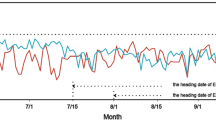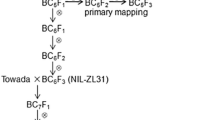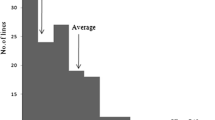Abstract
Low temperature at the booting stage of rice causes male sterility resulting in severe yield loss. Cold tolerance has long been an important objective in rice breeding. We identified a quantitative trait locus (QTL) for cold tolerance on the long arm of chromosome 3 from the cold-tolerant breeding line ‘Ukei 840’ by using F2 and BC1F2 populations from crosses between ‘Ukei 840’ and ‘Hitomebore’. The cold tolerance of ‘Ukei 840’ is derived from the Chinese cultivar ‘Lijiangxintuanheigu’. The effect of this QTL on cold tolerance was confirmed by developing ‘Hitomebore’ chromosome segment substitution lines having ‘Lijiangxintuanheigu’ alleles on chromosome 3. By producing recombinants in chromosome 3, the QTL region for cold tolerance was delimited to the region of about 1.2-Mb region between RM3719 and RM7000. All lines heterozygous for the QTL showed seed fertilities as low as that of ‘Hitomebore’, suggesting that the ‘Lijiangxintuanheigu’ allele for cold tolerance in the QTL region is recessive. Determination of a 1.2-Mb nucleotide sequence of ‘Ukei 840’ and comparison with the published genomic sequence of ‘Nipponbare’ showed 254 SNPs, of which 11 were in coding regions of genes, seven in five genes being non-synonymous. SNPs were detected in the 5-kb upstream regions of 89 genes, but no differences of gene expression levels were detected between alleles of these genes. Although further delimitation is required to identify the gene responsible for cold tolerance of ‘Lijiangxintuanheigu’, SNP markers developed here will be useful for marker-assisted selection in a breeding program using ‘Lijiangxintuanheigu’ as a donor of cold tolerance.






Similar content being viewed by others
References
Andaya VC, Mackill DJ (2003) QTLs conferring cold tolerance at the booting stage of rice using recombinant inbred lines from a japonica × indica cross. Theor Appl Genet 106:1084–1090
Dai L, Lin X, Ye C, Ise K, Saito K, Kato A, Xu F, Yu T, Zhang D (2004) Identification of quantitative trait loci controlling cold tolerance at the reproductive stage in Yunnan landrace of rice, Kunmingxiaobaigu. Breed Sci 54:253–258
Edwards K, Johnstone C, Thompson C (1991) A simple and rapid method for the preparation of plant genomic DNA for PCR analysis. Nucleic Acids Res 19:1349
Hayase H, Satake T, Nishiyama T, Ito N (1969) Male sterility caused by cooling treatment at the meiotic stage in rice plants. II. The most sensitive stage to cooling and the fertilizing ability of pistils. Proc Crop Sci Soc Jpn 38:706–711
Horisue N, Kunihiro Y, Higashi T, Oyamada Z, Huaiyi W, Jianhua X, Suchu Z, Zhiyong L, Yonghua W (1988) Screening for cold tolerance of Chinese and Japanese rice varieties and selection of standard varieties. Trop Agric Res Ser 21:76–92 (in Japanese with English summary)
International Rice Genome Sequencing Project (2005) The map-based sequence of the rice genome. Nature 436:793–800
International Rice Research Institute (1977) Screening for cold tolerance. IRRI annual report for 1977, pp 142
Ito N (1978) Male sterility caused by cooling treatment at the young microspore stage in rice plants. XVI. Changes in carbohydrates, nitrogenous and phosphorous compounds in rice anthers after cooling treatment. Jpn J Crop Sci 47:318–323
Jain M, Nijhawan A, Arora R, Agarwal P, Ray S, Sharma P, Kapoor S, Tyagi AK, Khurana JP (2007) F-box proteins in rice. Genome-wide analysis, classification, temporal and spatial gene expression during panicle and seed development, and regulation by light and abiotic stress. Plant Physiol 143:1467–1483
Jansen RC, Stam P (1994) High resolution of quantitative traits into multiple loci via interval mapping. Genetics 136:1447–1455
Koiwai H, Nakaminami K, Seo M, Mitsuhashi W, Toyomasu T, Koshiba T (2004) Tissue-specific localization of an abscisic acid biosynthetic enzyme, AAO3, in Arabidopsis. Plant Physiol 134:1697–1707
Kuroki M, Saito K, Matsuba S, Yokogami N, Shimizu H, Ando I, Sato Y (2007) A quantitative trait locus for cold tolerance at the booting stage on rice chromosome 8. Theor Appl Genet 115:593–600
Matsunaga K (2005) Establishment of an evaluation method for cold tolerance at the booting stage of rice using deep water irrigation system and development of highly cold-tolerant rice varieties by combining cold tolerance genes. Bull Miyagi Furukawa Agric Exp Stn 4:1–78 (in Japanese with English summary)
McCouch SR, Teytelman L, Xu Y, Lobos KB, Clare K, Walton M, Fu B, Maghirang R, Li Z, Xing Y, Zhang Q, Kono I, Yano M, Fjellstrom R, DeClerck G, Schneider D, Cartinhour S, Ware D, Stein L (2002) Development and mapping of 2240 new SSR markers for rice (Oryza sativa L.). DNA Res 9:199–207
Murray MG, Thompson WF (1980) Rapid isolation of high molecular weight plant DNA. Nucleic Acids Res 8:4321–4325
Nishiyama I (1970) Male sterility caused by cooling treatment at the young microspore stage in rice plants. VII. Electron microscopical observations on tapetal cells dilated by the cooling treatment. Proc Crop Sci Soc Japan 39:480–486
Nishiyama I (1978) Male sterility caused by cooling treatment at the young microspore stage in rice plants. XVIII. Some enzyme activities in anthers during and after the cooling. Jpn J Crop Sci 47:551–556
Oliver SN, Van Dongen JT, Alfred SC, Mamun EA, Zhao X, Saini HS, Fernandes SF, Blanchard CL, Sutton BG, Geigenberger P, Dennis ES, Dolferus R (2005) Cold-induced repression of the rice anther-specific cell wall invertase gene OSINV4 is correlated with sucrose accumulation and pollen sterility. Plant Cell Environ 28:1534–1551
Oliver SN, Dennis ES, Dolferus R (2007) ABA regulates apoplastic sugar transport and is a potential signal for cold-induced pollen sterility in rice. Plant Cell Physiol 48:1319–1330
Saito K, Miura K, Nagano K, Hayano-Saito Y, Saito A, Araki H, Kato A (1995) Chromosomal location of quantitative trait loci for cool tolerance at the booting stage in rice variety ‘Norin-PL8’. Breed Sci 45:337–340
Saito K, Miura K, Nagano K, Hayano-Saito Y, Araki H, Kato A (2001) Identification of two closely linked quantitative trait loci for cold tolerance on chromosome 4 of rice and their association with anther length. Theor Appl Genet 103:862–868
Saito K, Hayano-Saito Y, Maruyama-Funatsuki W, Sato Y, Kato A (2004) Physical mapping and putative candidate gene identification of a quantitative trait locus Ctb1 for cold tolerance at the booting stage of rice. Theor Appl Genet 109:515–522
Saito K, Hayano-Saito Y, Kuroki M, Sato Y (2010) Map-based cloning of the rice cold tolerance gene Ctb1. Plant Sci 179:97–102
Sasaki T (2005) Identification of rice germplasm for cold tolerance at the booting stage and breeding of Hitomebore, a cold-tolerant rice cultivar having excellent grain and eating quality. Bull Miyagi Furukawa Agric Exp Sta 4:79–128 (in Japanese with English summary)
Satake T, Hayase H (1970) Male sterility caused by cooling treatment at the young microspore stage in rice plants. V. Estimation of pollen developmental stage and the most sensitive stage to coolness. Proc Crop Sci Soc Jpn 39:468–473
Sato Y, Antonio BA, Namiki N, Takehisa H, Minami H, Kamatsuki K, Sugimoto K, Shimizu Y, Hirochika H, Nagamura Y (2011) RiceXPro: a platform for monitoring gene expression in japonica rice grown under natural field conditions. Nucleic Acids Res 39:D1141–D1148
Seo M, Aoki H, Koiwai H, Kamiya Y, Nambara E, Koshiba T (2004) Comparative studies on the Arabidopsis aldehyde oxidase (AAO) gene family revealed a major role of AAO3 in ABA biosynthesis in seeds. Plant Cell Physiol 45:1694–1703
Shiokai S, Kitashiba H, Shirasawa K, Nagano K, Nishio T (2009) Leaf-punch method to prepare a large number of PCR templates from plants for SNP analysis. Mol Breed 23:329–336
Shiokai S, Shirasawa K, Sato Y, Nishio T (2010) Improvement of the dot-blot-SNP technique for efficient and cost-effective genotyping. Mol Breed 25:179–185
Shirasawa K, Kishitani S, Nishio T (2004a) Conversion of AFLP markers to sequence-specific markers for closely related lines in rice by use of the rice genome sequence. Mol Breed 14:283–292
Shirasawa K, Monna L, Kishitani S, Nishio T (2004b) Single nucleotide polymorphisms in randomly selected genes among japonica rice (Oryza sativa L.) varieties identified by PCR-RF-SSCP. DNA Res 11:275–283
Shirasawa K, Shiokai S, Yamaguchi M, Kishitani S, Nishio T (2006) Dot-blot-SNP analysis for practical plant breeding and cultivar identification in rice. Theor Appl Genet 113:147–155
Suh JP, Jeung JU, Lee JI, Choi YH, Yea JD, Virk PS, Mackill DJ, Jena KK (2010) Identification and analysis of QTLs controlling cold tolerance at the reproductive stage and validation of effective QTLs in cold-tolerant genotypes of rice (Oryza sativa L.). Theor Appl Genet 120:985–995
Takeuchi Y, Hayasaka H, Chiba B, Tanaka I, Shimano T, Yamagishi M, Nagano K, Sasaki T, Yano M (2001) Mapping quantitative trait loci controlling cool-temperature tolerance at booting stage in temperate Japonica rice. Breed Sci 51:191–197
Toriyama K, Futsuhara Y (1960) Genetic studies on cool tolerance in rice. I. Inheritance of cool tolerance. Jpn J Breed 10:7–16 (in Japanese)
Ye C, Fukai S, Godwin ID, Koh H, Reinke R, Zhou Y, Lambrides C, Jiang W, Snell P, Redona E (2010) A QTL controlling low temperature induced spikelet sterility at booting stage in rice. Euphytica 176:291–301
Zeng ZB (1994) Precision mapping of quantitative trait loci. Genetics 136:1457–1468
Acknowledgments
This study was partly supported by a Grant-in-Aid for Scientific Research (Research Activity Start-up: 22880005).
Author information
Authors and Affiliations
Corresponding author
Additional information
Communicated by J. Dubcovsky.
Electronic supplementary material
Below is the link to the electronic supplementary material.
122_2011_1758_MOESM1_ESM.tif
Supplementary Fig. 1 QTL analysis using a backcrossed population. (a) Seed fertilities of backcross population after cultivation under low temperature conditions at the booting stage. (b) Position of a QTL detected using a backcrossed population. Black boxes indicate regions having segregated genotypes and white boxes show regions having a fixed genotype of homozygous ‘Hitomebore’ alleles. A circle represents a QTL region. A gray bar indicates candidate region of the QTL and a triangle shows the peak of the LOD score. (TIFF 86 kb)
Rights and permissions
About this article
Cite this article
Shirasawa, S., Endo, T., Nakagomi, K. et al. Delimitation of a QTL region controlling cold tolerance at booting stage of a cultivar, ‘Lijiangxintuanheigu’, in rice, Oryza sativa L.. Theor Appl Genet 124, 937–946 (2012). https://doi.org/10.1007/s00122-011-1758-6
Received:
Accepted:
Published:
Issue Date:
DOI: https://doi.org/10.1007/s00122-011-1758-6




